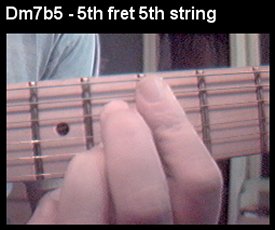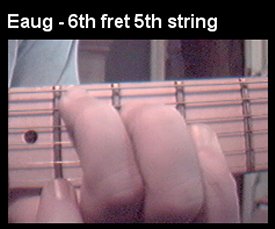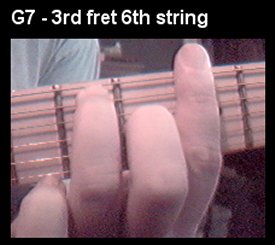Scroll through the lesson and click on notation/video/audio links to load the interactive players.
Please subscribe to get full access to all lessons for only $7.95/month PLUS 1 week free trial.

Riff Interactive lessons are
LESS expensive and
MORE interactive than alternatives!
More Info
|
|
| Lesson Subject:
Brian Setzer Style |
| What you learn:
Lesson 5 |
| Teacher:
Rusty Cash |
Rusty: In this class we'll look at a swing example and some licks that will follow along with it. The
example is based off of the C harmonic minor scale. We'll explore this scale and
add some of Brian's signature licks to help make you sound like "Stray Cat Strut".
Lesson
Example
Jam Track
Rusty: The harmonic minor scale follows this
step pattern ( 1 - 2 - b3 - 4 - 5 - b6 - 7 ).
Rusty: These are the two main scale forms I
used to build the leads. Play the scale by itself and it will work over the
whole jam track. You can also use the C minor blues with
our example. Here is the scale I mainly used for the
example.
Rusty:
The combination of those two scales will make some nice Setzer licks. I'll show
you more when we cover the licks. Because of the step pattern in the
harmonic minor scale, we get some interesting chords that can be used for the
rhythm. You don't have to use three or four tone chords. You could play power
chords or fifths built off of the notes in the scale. I do that over the first 4
bars of the example. With this type of music there is
normally a melody created with the leading tones of each chord. You may think of
that as the bass line. That's how I came up with this example. You could fool
around with the scale and make up your own melody. Then go back and substitute
the full chords in your song.
Rusty: After coming up with a rhythm or melody
I used the following chart to substitute in the full chords. I play these over
the 2nd 4 bars.
Four Tone
Chords

Rusty: That gives us
the following rhythm chart.

Rusty: Notice I used Cm and Eb aug
rather than the full 4 tone chord You can use either one and they will work for
this lesson. Here are the chord positions I used or
would use for the 4 tone chords.
Cm

Dm7b5

Eaug

G7

Video 1
Rusty: That takes care of the chords you
could use in the rhythm. Next I would pick out some other voicings or triads
that would work along with the rhythm. Here is an example of that. I need to make
a correction. On the tab I have E aug as a chord and that needs to be
Eb aug. The video shows you how I'd play this rhythm part. Notice how
I brush the strings with my thumb and index. You can be as dynamic as you
like, by playing hard or soft.
Video 2
Rusty:
This lick should
sound like the intro lick to "Stray Cat Strut". It starts with a normal rock
lick bending through the blues scale. Then it plays each note of the G augmented
chord, which will work all over this song. You can normally substitute your V
chord with its augmented (#5) chord. Turning it into a lick is one thing that
makes Setzer's playing different.
Rusty:
This small bit comes out of the C harmonic minor scale. I
emphasize the crucial note to that scale as the last note. I'm trying to setup
the sound of that scale so I can use it later and compare Brian's licks with the
scale.
Video 3
Rusty:
Over this part
I'm using some chromatics and taking advantage of backing chords Ab and G7. It
still has a touch of the C harmonic minor with additional passing
tones.
Rusty: Here's another lick that is similar to the way Setzer phrases his
licks. Again we start with a bend out of the C minor blues and move into some
swing. The next lick will tie it all together.
Video 4
Rusty:
This part emphasizes the 1/2 step intervals within the harmonic minor but he also
throws in the b5 ( from the C minor blues) note that jazzes up the lick and also
combines the two scales together. The last part of the lick I threw in a
diminished arpeggio to get us back up to the root note.
Rusty: Now
we're back into the C minor blues scale and using some of the diminished
voicings that is comparable to Setzer's style. By now you should see that all
along you want to merge the two scales together. Basically take some blues or
rock licks that you know and in a few runs from the C harmonic minor scale and
you'll start to sound like Setzer.
Video 5
Rusty:
Same thing
happens here. I use some pull - offs from the C minor blues and head right back
into the G augmented chord. From this point on I'm experimenting with the C
harmonic minor. While trying to build my own licks, I'm thinking of the few
things I covered before that will help me sound close to Setzer or either swing.
Video 6
Rusty:
This is another
lick from our blues scale. The phrasing make's it different and
interesting.
Rusty:
Now I'm taking
the idea of adding the b5 from the blues scale with the C harmonic scale. By
using the 1/2 step intervals I can come up with something that sounds
diminished.
Video 7
Rusty:
Another little
ditty using the harmonic minor.
Rusty:
This lick
resolves lick 12.
Video 8
Rusty:
This lick
emphasizes the C minor triad.
Video 9
Rusty:
This lick sets up
the next lick. I'm trying to emphasize the C minor triad again in a different
position.
Rusty:
Lick 16 sums it
all up by arpeggiating through the C minor triad, the C diminished, the B
diminished, and ending on the minor third.
Video 10
Rusty:
Good Luck and I hope enjoy the
CD! - Rusty
|
<< load notation from left
|
|
<< load audio from left
|
<< load audio from left
|